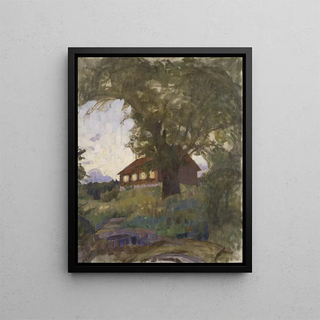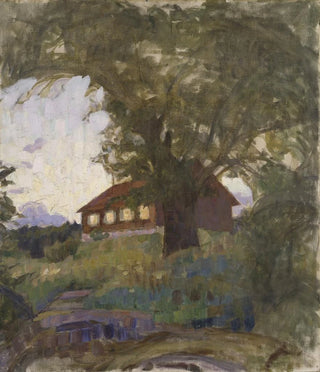Art print | La Maison des Vergers à Tyresö - Richard Bergh


View from behind

Frame (optional)
Reproduction of The House of Orchards in Tyresö - Richard Bergh – Captivating Introduction
The House of Orchards in Tyresö, an iconic work by Richard Bergh, evokes an atmosphere of serenity and contemplation. This painting, which captures the tranquil beauty of a Swedish landscape, invites the viewer to immerse themselves in a world where nature and architecture harmoniously meet. The artist, through this piece, manages to convey a sense of peace and harmony, paying tribute to the beauty of Nordic landscapes. This representation, both realistic and poetic, embodies the very essence of Scandinavian painting from the late 19th century, a period when art served nature and emotion.
Style and uniqueness of the work
The House of Orchards in Tyresö stands out through its subtle use of light and color. Bergh, a true master, plays with nuances to create delicate shadows and shimmering reflections on surfaces. The work is characterized by a balanced composition, where each element finds its place, whether it be the majestic trees or the house itself, which seems to blend into its environment. The meticulous details, such as the leaves trembling in the breeze or the play of light on the house walls, demonstrate attentive observation and great artistic sensitivity. This painting does not merely depict a landscape; it evokes an atmosphere, an emotion, an invitation to daydream.
The artist and his influence
Richard Bergh, an emblematic figure of the Swedish artistic movement, knew how to mark his era with his innovative approach and respect for nature. Born in 1858, he was influenced by the great masters of painting, while developing a style unique to himself. His passion for plein air painting and his ability to capture natural light made him a pioneer in landscape art. Bergh also played an important role in promoting Swedish art internationally, participating in numerous exhibitions and contributing to the emergence of a national artistic identity. His work, The House of Orchards in Tyresö, is part of this quest for authenticity

Matte finish

View from behind

Frame (optional)
Reproduction of The House of Orchards in Tyresö - Richard Bergh – Captivating Introduction
The House of Orchards in Tyresö, an iconic work by Richard Bergh, evokes an atmosphere of serenity and contemplation. This painting, which captures the tranquil beauty of a Swedish landscape, invites the viewer to immerse themselves in a world where nature and architecture harmoniously meet. The artist, through this piece, manages to convey a sense of peace and harmony, paying tribute to the beauty of Nordic landscapes. This representation, both realistic and poetic, embodies the very essence of Scandinavian painting from the late 19th century, a period when art served nature and emotion.
Style and uniqueness of the work
The House of Orchards in Tyresö stands out through its subtle use of light and color. Bergh, a true master, plays with nuances to create delicate shadows and shimmering reflections on surfaces. The work is characterized by a balanced composition, where each element finds its place, whether it be the majestic trees or the house itself, which seems to blend into its environment. The meticulous details, such as the leaves trembling in the breeze or the play of light on the house walls, demonstrate attentive observation and great artistic sensitivity. This painting does not merely depict a landscape; it evokes an atmosphere, an emotion, an invitation to daydream.
The artist and his influence
Richard Bergh, an emblematic figure of the Swedish artistic movement, knew how to mark his era with his innovative approach and respect for nature. Born in 1858, he was influenced by the great masters of painting, while developing a style unique to himself. His passion for plein air painting and his ability to capture natural light made him a pioneer in landscape art. Bergh also played an important role in promoting Swedish art internationally, participating in numerous exhibitions and contributing to the emergence of a national artistic identity. His work, The House of Orchards in Tyresö, is part of this quest for authenticity






